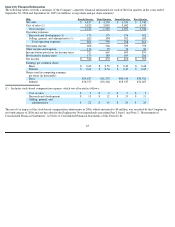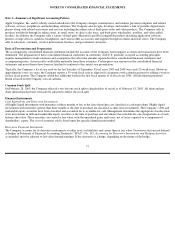Apple 2006 Annual Report Download - page 72
Download and view the complete annual report
Please find page 72 of the 2006 Apple annual report below. You can navigate through the pages in the report by either clicking on the pages listed below, or by using the keyword search tool below to find specific information within the annual report.
Foreign Currency Risk
In general, the Company is a net receiver of foreign currencies. Accordingly, changes in exchange rates, and in particular a strengthening of the
U.S. dollar, may negatively affect the Company’s net sales and gross margins as expressed in U.S. dollars. There is also a risk the Company
will have to adjust local currency product pricing due to competitive pressures when there has been significant volatility in foreign currency
exchange rates.
The Company may enter into foreign currency forward and option contracts with financial institutions to protect against foreign exchange risks
associated with existing assets and liabilities, certain firmly committed transactions, forecasted future cash flows, and net investments in
foreign subsidiaries. Generally, the Company’s practice is to hedge a majority of its existing material foreign exchange transaction exposures.
However, the Company may not hedge certain foreign exchange transaction exposures due to immateriality, prohibitive economic cost of
hedging particular exposures, and limited availability of appropriate hedging instruments.
To provide a meaningful assessment of the foreign currency risk associated with certain of the Company’s foreign currency derivative
positions, the Company performed a sensitivity analysis using a value-at-risk (“VAR”) model to assess the potential impact of fluctuations in
exchange rates. The VAR model consisted of using a Monte Carlo simulation to generate 3,000 random market price paths. The VAR is the
maximum expected loss in fair value, for a given confidence interval, to the Company’s foreign exchange portfolio due to adverse movements
in rates. The VAR model is not intended to represent actual losses but is used as a risk estimation and management tool. The model assumes
normal market conditions. Forecasted transactions, firm commitments, and assets and liabilities denominated in foreign currencies were
excluded from the model. Based on the results of the model, the Company estimates with 95% confidence a maximum one-day loss in fair
value of $9.2 million as of September 30, 2006 compared to a maximum one-day loss of $10.0 million as of September 24, 2005. Because the
Company uses foreign currency instruments for hedging purposes, losses incurred on those instruments are generally offset by increases in the
fair value of the underlying exposures.
Actual future gains and losses associated with the Company’s investment portfolio and derivative positions may differ materially from the
sensitivity analyses performed as of September 30, 2006 due to the inherent limitations associated with predicting the changes in the timing and
amount of interest rates, foreign currency exchanges rates, and the Company’s actual exposures and positions.
71
























